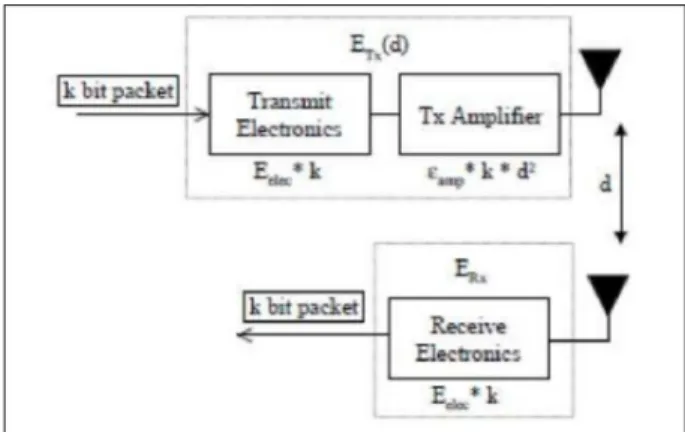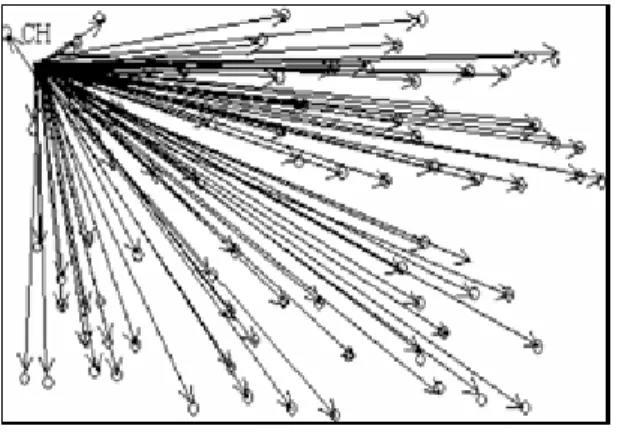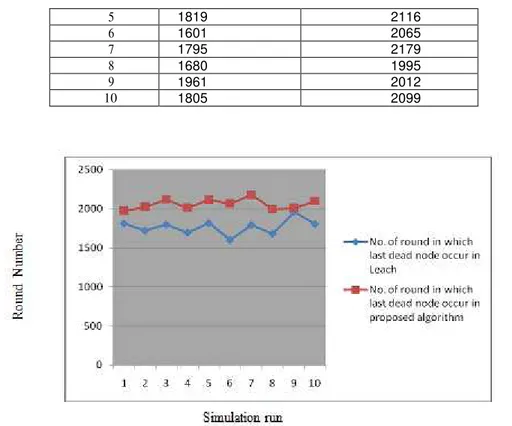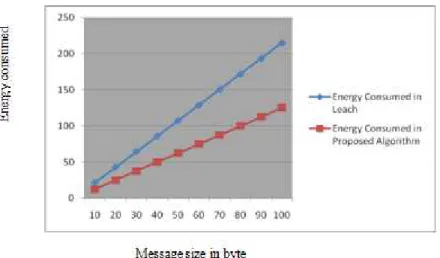International Journal of Ad hoc, Sensor & Ubiquitous Computing (IJASUC) Vol.2, No.3, September 2011
S. Taruna
1 ,Jain Kusum Lata
2, Purohit G.N
3Computer Science Department, Banasthali University, India
1
staruna71@yahoo.com
2kusum_2000@rediffmail.com 3
gn_purohitjaipur@yahoo.co.in
Abstract:
Wireless Sensor Networks, are made of low-cost, low-power, small in size, and multifunctional sensor nodes. The efficient energy utilization is one of the important performance factors for wireless sensor networks survivability be-cause nodes operate with limited battery power. In this paper we propose and analyze a new approach of zone based clustering head selection algorithm for wireless sensor network of homogeneous nodes. Nodes in the network are uniformly distributed. In this clustering algorithm, network performance is improved by selecting cluster heads on the basis of the residual energy of existing cluster heads, and nearest hop distance of the node. In this paper we evaluate various performance metrics like energy consumption, network life time, number of channel heads metrics in each round and compare these with respect to random algorithm i.e. LEACH. We conclude that proposed protocol effectively extends the network lifetime without degrading the other critical overheads and perform-ance metrics.
Keyword:
Wireless Sensor network, Zone, Clustering Algorithm, Residual Energy.
1 . Introduction
The main constraint in designing a routing protocol in WSNs is limited power of sensor nodes that mandates the design of energy-efficient communication protocol. There are many protocols proposed for other wireless networks like mobile or ad-hoc. How-ever, these protocols cannot be used directly due to resource constraints of sensor nodes like limited battery power, computational speed, and human interface of node device and density of nodes in network. Much research has been done in recent years, but even after many efforts, there are still many design options open for improvement. Thus, there is a need of a new protocol scheme, which enables more efficient use of energy at individual sensor nodes to enhance the network survivability. In this paper, we analyze energy efficient homogeneous clustering head selection algorithm for WSN. We first describe the protocol and then we provide simulation results in MATLAB [9] and determine performance analysis of given protocol compared with benchmark clustering algorithm LEACH.
The paper is organized as follows. Section 2 summarizes the related previous works Section 3 discusses the basic radio energy model. Section 4 describes the proposed homogeneous clustering algorithm. Simulation results are presented in section 5 .Comparisons with random LEACH algorithm in section 6. Conclusions and suggestions for future work are given in section 6.
2 . Related Work
Routing is a process of determining a path between source and destination upon re-quest of data transmission. A variety of protocols have been proposed to enhance the life of WSN and for routing the correct data to the base station. Battery power of individual sensor nodes is a precious resource in the WSN [3]. For example, the power consumed by a Berkeley mote to transmit 1-bit of data is equivalent to the computation of 800m instructions. When the battery power at a sensor node expires, the node is called as a dead node and the sensor node discontinues its operations in the network.
In general, routing in WSN can be divided into flat-based routing, hierarchical-based routing, and location-based[10] routing depending on the network structure. In flat-based routing, all nodes are typically assigned equal roles or functionality. In hierarchical-based routing, however, nodes will play different roles in the network. In location-based routing, sensor nodes positions are exploited to route data in the net-work.
Hierarchical routing performs energy-efficient routing in WSN, and contributes to overall system scalability and lifetime. In a hierarchical architecture, sensors organize themselves into clusters and each cluster has a cluster head, i.e. sensor nodes form clusters where the low energy nodes are used to perform the sensing in the proximity of the phenomenon. For the cluster based wireless sensor network, the cluster information and Cluster Head (CH) selection are the basic issues. The cluster head coordinates the communication among the cluster members and manages their data [11].
According to the manner the data are collected, cluster based WSNs are classified into three broad categories namely (i) homogeneous sensor networks, (ii) heterogeneous sensor network , (iii) hybrid sensor network.
International Journal of Ad hoc, Sensor & Ubiquitous Computing (IJASUC) Vol.2, No.3, September 2011 cluster heads. As proposed in LEACH [4], the role of cluster heads is randomly and periodically rotated over all the nodes to ensure the same rate of dissipation of battery power for all the sensor nodes.
(ii)Heterogeneous sensor networks, has two or more different types of sensor nodes with different hardware capabilities and battery power are used. The sensor nodes with higher hardware capabilities and more battery power compared to other sensor nodes act as cluster heads and perform as a normal sensor node.
(iii)In hybrid sensor networks several mobile base stations work cooperatively to provide fast data gathering in a real-time manner.
Low-energy adaptive clustering hierarchy (LEACH) is a popular energy-efficient adaptive clustering algorithm that forms node clusters based on the received signal strength and uses these local cluster heads as routers to the base station [7]. LEACH is an application-specific data dissemination protocol that uses clusters to prolong the life of the wireless sensor network. LEACH utilizes randomized rotation of local cluster heads to evenly distribute the energy load among the sensors in the network [4]. LEACH uses three techniques namely (i) randomized rotation of the cluster heads and corresponding clusters, (ii) localized coordination and control for cluster set-up and operation, and (iii) local compression to reduce global communication. LEACH clustering terminates in a finite number of iteration, but does not guarantee good cluster head distribution and assumes uniform energy consumption for cluster heads.
The author in [8] has proposed a theoretical model for energy efficient routing in homogeneous sensor network but did not implement and evaluate the performance of the protocol in any simulator. In this study we consider the impact of the model and its behavior with respect to benchmark LEACH protocol. Our paper has highlighted the practical implementation of protocol in MATLAB and determines various performance metrics like energy consumption, network lifetime, number of cluster heads in each round.
3 . Network and Energy Consumption Model
We assume that the energy consumption of the sensor is due to data transmission and reception. Cluster head consume energy for the data aggregation before it sends the data to BS. We use the same radio model as stated in [4] and shown in Figure 1, using this model the energy consumed in transmitting one message of size k bits over a transmission distance d, is given by
ETx(k,d)=k(Eelec + AMPd )= Eelec k + k AMPd
, ,
where k=length of the message,
d=transmission distance between transmitter and receiver, Eelec=
electronic energy,
AMP=transmitter amplifier, = Path Loss
(2<= <=4),
Also, the energy consumed in the message reception is given by
E
rx
= E
elec
Figure 1: Energy Model for algorithm
4. The Proposed Homogeneous Clustering Algorithm [8]
4.1
Basic assumptions for the clustering algorithm
• Number of nodes in network are 100.
• The base station (BS) is located outside the deployed area and fixed. • All nodes can send data to BS.
• The BS has the information about the location of each node. • Data compression is done by the Cluster Head.
• Data Compression energy is different from the reception and transmission. • In the first round, each node has a probability p of becoming the cluster head.
• A node, which has become cluster head, shall be eligible to become cluster head after
1-1/p rounds.
• All nodes are of same specification.
• All nodes in the network are having the same energy at starting point and having maximum energy.
• All nodes consume same energy for transmission and reception.
• Energy of transmission depends on the distance (source to destination) and data size. • Nodes are uniformly distributed in network.
4.2
Proposed Algorithm
The proposed algorithm works in round. Each round has the setup and transmission phase.
Setup phase:
International Journal of Ad hoc, Sen
Figure
2. All nodes send data to B 3. Nodes belonging to a re
F
4. A random node from the
F
5. Selected cluster head sen nodes in the network
Sensor & Ubiquitous Computing (IJASUC) Vol.2, No.3, Se
re 2: Homogeneous Network with 100 nodes
BS about their location.
rectangle create a group called pre-cluster.
Figure 3:Precluster
the pre-cluster is selected as cluster head.
Figure 4: Cluster head
sends advertisement of their cluster as joining request t
September 2011
Figure 5: Selected cluster head send JOIN request to all other node in network
6. On the basis of the distance the nodes select one cluster head, which is most near to it. 7. The nodes send confirmation by ACK to cluster head. And final cluster formation is
done.
Figure6: Final Cluster formation
8. The node of a pre-cluster may lie in another final cluster.
Transmission Phase:
Nodes send the sensed data to the Cluster Head and CH performs aggregation and compression on data and sends it to Base Station.
New Cluster Head (CH) Formation
New CH is selected by checking the residual energy of cluster head. If the energy of the current CH is less then threshold level, new CH is selected . New CH is to be selected depending on the following criteria:
• A node has not become a CH for the past (1-1/p) round.
• The node is having the maximum residual energy in the cluster. • The node, which is nearest to existing cluster head in cluster.
5
.Performance Evaluations
International Journal of Ad hoc, Sensor & Ubiquitous Computing (IJASUC) Vol.2, No.3, September 2011 selection) in terms of the network lifetime.
5.1 Simulation Parameter
Table 1: Simulation Parameters
5.2
Simulation Result
1. Energy Consumption: -We simulated the proposed and random algorithm(LEACH) for 10 times and determined the cluster with the maximum number of nodes. We calculated the energy for the control packet size (ctrPacketLength) of 100 bytes.
Power consumption in random selection method for cluster head is
E consume=Energy for the reception of data for all nodes in cluster
+ Send the CH information to Base station. =(ERX*ctrPacketLength *N)
+ EDA
+ (ETX *ctrPacketLength+Emp*ctrPacketLength)
(* Is path loss and we consider the same path loss for all the nodes. Path Loss can be in the range 2 to 4) (In the simulation we assumed path loss as 3.)
Parameter Values
Simulation Round 3000
Topology Size 200 X 200
Number of nodes 100
CH probability 0.5
Initial node power 0.5 Joule
Nodes Distribution Nodes are uniformly distributed
BS position Located at (100,250)
Table2: Simulation result
No. of Simulation run
Max. no. of nodes in proposed algorithm
Max. no. of nodes in Leach
Energy consumed in Leach in J/mS
Energy consumed in proposed algorithm in J/mS
1 25 50 25.50050001 13.00050001
2 27 46 23.50050001 14.00050001
3 24 38 19.50050001 12.50050001
4 23 29 15.00050001 12.00050001
5 21 37 19.00050001 11.00050001
6 22 30 15.50050001 11.50050001
7 27 32 16.50050001 14.00050001
8 24 39 20.00050001 12.50050001
9 26 35 18.00050001 13.50050001
10 24 42 21.50050001 12.50050001
Figure7: Energy consumption of nodes for cluster selection.
2. Network Life Time: -
When first node is nead:- In the random selection method cluster head selection in each round is done on the basis of 1/p, but not on the basis of residual energy.
The cluster head is determined by the following function: -
Pt if n € G
T(n) = ______________
1-Pt.(r.mod i/Pt) 2
International Journal of Ad hoc, Sensor & Ubiquitous Computing (IJASUC) Vol.2, No.3, September 2011 Where Pt is the desired percentage of cluster heads, r is the current round number; G is the set of nodes that have not been cluster-heads in the last 1/Pt rounds.
When a node is dead in the network it will not be the part of the network. It shows that if a dead node occurs in early rounds of the algorithm, this may affect lifespan of the network or drag towards the early dead of all nodes.
Table3: Network Life Time (first dead node)
No. of simulation
No. of round in which first dead node occur in Leach
No. of round in which first dead node occur in proposed algorithm
1 516 745
2 552 792
3 541 683
4 494 782
5 511 743
6 520 740
7 535 692
8 549 699
9 562 763
10 501 635
Figure8: Network Life Time(first dead node)
When entire nodes get dead :-Similarly when all nodes are dead in the network, the lifespan of network is over. That is , lesser the round number when all nodes are found dead, lesser is the network lifespan. Hence the round number in which all nodes are found dead is the last round.
Table4: Network Life Time(all nodes dead)
No. of simulation
No. of round in which last dead node occur in Leach
No. of round in which last dead node occur in proposed algorithm
1 1813 1975
Figure9 : Network Life Time(all nodes dead)
3. Energy Consumption with varying message size:- We simulated with themaximum number of node that is 42 in Leach and 24 in the proposed method with different message size; energy consumption is shown in following table
Table 5: Energy Consumption for cluster head selection for different message
5 1819 2116
6 1601 2065
7 1795 2179
8 1680 1995
9 1961 2012
10 1805 2099
Energy Consumed in Leach in J Energy Consumed in
Pro-Message size in Byte
posed Algorithm in J
10 21.505000 12.505000
20 43.005000 25.005000
30 64.505000 37.505000
40 86.005000 50.000000
50 107.505000 62.505000
60 129.005000 75.005000 70 150.505000 87.505000 80 172.005000 100.005000
90 193.505000 112.505000
International Journal of Ad hoc, Sensor & Ubiquitous Computing (IJASUC) Vol.2, No.3, September 2011 Figure 10: Energy Consumption for different message size
4. Residual Energy with varying message size:- We simulated with themaximum number of node that is 46 in Leach and 27 in the proposed method with different message size; residual energy is computed where initial energy Eo = 0.5Joules . Residual energy shown in following table.
Table 6: Residual Energy for cluster head selection for different message size
Residual Energy in Leach mJ Residual Energy in
Pro-Message size in KByte
posed Selection mJ
10 476.49 485.90
20 452.90 471.90
30 429.40 457.90
40 405.90 443.90
50 382.49 429.90
60 358.99 415.90
70 335.99 401.90
80 311.99 387.90
90 288.49 373.90
Figure 11: Residual Energy for different message size
6.Conclusion and future work:
In this paper, we have proposed a new technique to distribute the role of cluster head among some of the wireless sensor nodes based on their residual energy. The proposed new technique aims to increase the lifetime of the whole network, and to increase the number of nodes, which will remain alive for the maximum period of time. The performance evaluation in terms of network lifetime was conducted using MATLAB. We compared the LEACH protocol with the new technique under the same simulation condition and values. Results show that the new proposed technique has improved the performance in terms of increasing the network lifetime and we have also determined the impact of message length in the energy consumption. Since energy consumption increases with the message size, result shows that Leach consumes more energy than proposed method. The proposed algorithm is for the homogeneous network and we propose to extend this work for the heterogeneous network.
References
[1] I.F. Akyildiz, W. Su, Y. Sankarasubramaniam, and E. Cayirci, “A Survey on Sensor Network”, IEEE Communication Magazine 40, 8 (August 2004), pp. 102-114.
[2] G. Martin, “An Avaluation of Ad-hoc Routing Protoco ls for Wireless Sensor Networks”, Master's thesis,School of Computing Science, Newcastle Univer-sity upon Tyne, U.K., May 2004.
[3] W.R. Heinzelman,A. Chandrakasan, and H. Balakrishnan, “Energy-Efficient Communication Protocol for Wireless Microsensor Networks”, in IEEE Computer Society Proceedings of the Thirty Third Hawaii International Conference on System Sciences (HICSS '00), Washington, DC, USA, Jan. 2000.
International Journal of Ad hoc, Sensor & Ubiquitous Computing (IJASUC) Vol.2, No.3, September 2011 [4] W.R. Heinzelman, A. Chandrakasan, and H. Balakrishnan, “An Application-Specific Protocol
Architecture for Wireless Microsensor Networks” in IEEE Tmnsactions on Wireless Communications (October 2002), vol. 1(4), pp. 660-670.
[5] G.J. Pottle, and W.J. Kaiser, “Embedding the I nternet: Wireless Integrated Network Sensors”, Communications of the ACM 43,5 May 2000],pp. 51-58.
[6] D.J. Baker, and A. Ephremides, “The Architectu ral Organization of a Mobile Radio Network via a Distributed Algorithm”, IEEE Transactions on Communications, vol. 29, no. 11, Nov. 1981, pp 1694- 1701.
[7] W.R. Heinzelman, A. Chandrakasan, and H. Balakrishnan, “An Application-specific Protocol Architecture for Wireless Microsensor Networks”, IEEETransactions on Wireless Communications,
vol. 1(4), Oct. ’02.
[8] Shio Kumar Singh, M P Singh, and D K Singh, “Energy Efficient Homoge-nous Clustering Algorithm for Wireless Sensor Networks”, International Journal of Wireless & Mobile Networks ( IJWMN ), Vol.2, No.3, August 2010.
[9] www. Mathworks.com
[10] J. Al-Karaki, and A. Kamal, “Routing Technique s in Wireless Sensor Net-works: A Survey“, IEEE Communications Magazine, vol 11, no. 6, Dec. 2004, pp. 6-28.
[11] C.R. Lin, and M. Gerla, “Adaptive Clustering f or Mobile Wireless Net-works”, IEEE Journal on Selected Areas in Communication, vol. 15, no. 7, Sept. 1997, pp. 11265-1275.
Authors
S.TARUNA received her B.Sc and M.Sc from Rajasthan University, Jaipur, Rajsthan, India, in 1989 and ,1991 respectively and her PhD is in progress from Banasthali University, Rajasthan , India. She is currently working as Assistant Professor in Department of Computer Science at Banasthali University , Rajasthan, India. Her research area includes field of communication, mobile and, sensor network
.
KUSUM LATA JAIN received her M.sc and M.Tech degress from Bansthali University, Rajasthan, India , in 2009 and 2011.Her interest is in the field of communication network.






